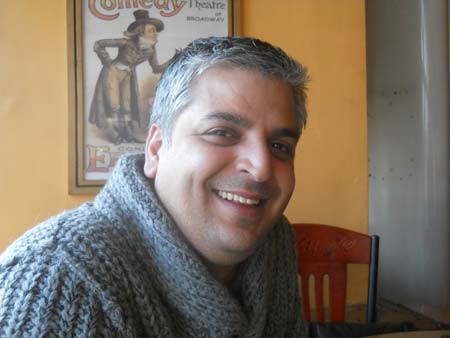A major disaster prompted a Kashmiri entrepreneur to involve himself in developing a unique software, one that aims to improve tsunami detection and management. Tasavur Mushtaq reports on a man who refused to take no as an answer.
 He tried and failed, and then tried and tried again. Ishfaq Mir’s persistence and determination have served him well, and today he is a proud Kashmiri behind a unique and valuable software being used in many parts of the world—the Integrated Tsunami Research and Information System (ITRIS). This software is helping several countries detect tsunamis, and effectively implement disaster management strategies.
He tried and failed, and then tried and tried again. Ishfaq Mir’s persistence and determination have served him well, and today he is a proud Kashmiri behind a unique and valuable software being used in many parts of the world—the Integrated Tsunami Research and Information System (ITRIS). This software is helping several countries detect tsunamis, and effectively implement disaster management strategies.
Ishfaq was a young student in 1991when escalating instability hit his family’s handicraft business in Kashmir and they branched out to various states of India. “We started 20 odd stores across the country,” Ishfaq said. For a few years, things went well. But then Ishfaq says he understood the reality of his business, “It was either overpricing the client, or selling substandard products,” he said. In 1995, he stared the “painful exercise” of winding up the business. But he did not lose hope, and started a designing house for Khatamband and carpets.
Shutting down the big family business had its toll, so when his friend offered a week’s trip to New York, he grabbed it. From there he started a medical transcription center based in India. At the time, India had only one such center and Ishfaq’s venture added the element of voice recognition for the software, suggested by a Chicago-based Kashmiri doctor. The product was called Dragon. “I thought Dragon would replace existing transcription services, but it failed to evolve,” he said.
An accident in New York put an end to his frequent visits to India. But he wasn’t discouraged, and started another line of business—trading. Ishfaq employed three individuals and started a small trading company on NASDAQ. He had an inclination towards designing, and with the help of his friend, Ishfaq created a high-end brand focused on designer accessories, called “iffeeselect.” His brand was introduced in all leading departmental stores, and soon it expanded from premium markets to mass markets and gained popularity in some other countries as well.
In 2001 fate had something difficult in store for Ishfaq when his sister met with a fatal accident in Kashmir and so he quickly flew back home. Ishfaq lost the hope of going back to New York.His business—which generated a few million dollars a year—was no more. “I lost everything that I had built there,” he says. “But not the courage to fight back.” Ishfaq started having trade shows all over the world. “It took me two years to revive,” he says. Carrying a truck load of samples, he visited different countries. “We started forward thinking projects,” he says.
Ishfaq was contemplating having a fashion house in India, when disaster struck. Towards the end of 2004, a massive series of tsunamis tore through the coasts along the Indian Ocean, killing over 230,000 people in 14 countries. The disaster made Ishfaq think critically, and he talked to a childhood friend of his in Dubai who was working on a tsunami software. Curious to learn more, Ishfaq got the opportunity to meet the Swiss agency working on earthquakes and tsunamis. “We started understanding the process,” says Ishfaq.
“Max Wics told us there is a huge risk in the region, so we had to understand city design and planning.” With this in mind, they started World Agency of Planetary Monitoring and Earthquake Risk Reduction India (WAPMERR India). To start off, the company proposed their plans to the Department of Science and Technology, which gave them the task of creating a 3D map of Chandni Chowk and the unauthorized constructions in the surrounding areas. “We did it,” Ishfaq says with a smile. They employed a large team, used five long range cameras and created a full-fledged surveillance room. They were able to identify 500 unauthorized constructions per month, when initially others were able to identify only a few.
As director of the company, Ishfaq proposed a project of 3D mapping to the Indian National Center for Ocean Information Services (INCOIS), who agreed to a pilot project in some areas of Tamil Nadu. “We successfully mapped 500 sq kilometers and implemented different mitigation plans,” he said. They gradually received help from a Russian academy and several scientists, and developed a mathematical model to understand water movement. The software—ITRIS—produced by Ishfaq’s company, has replaced a Japanese software.
Relating voices in water with visuals, the software provides all the intricate details required. “This helps in specifying areas and reducing panic,” he says. Ishfaq says ITRIS is planning an upgrade so that it can prove beneficial for flood, traffic and disaster management. However, Ishfaq believes red tape and nepotism has been a hurdle. “We have been waiting for three years to implement the second stage,” he says. To sustain their existence, the company is taking up smaller projects, such as providing utility mapping for the APDRP.
Without losing hope, Ishfaq shifted his base from Delhi to Kashmir. He has started four community centers to test his solutions and increase awareness. He is also planning on having incubation centers for budding entrepreneurs, and will help them in product marketing and development.
Ishfaq says he could easily spend his entire life in Europe, but wants to contribute to Kashmir. “This is my social responsibility.”















